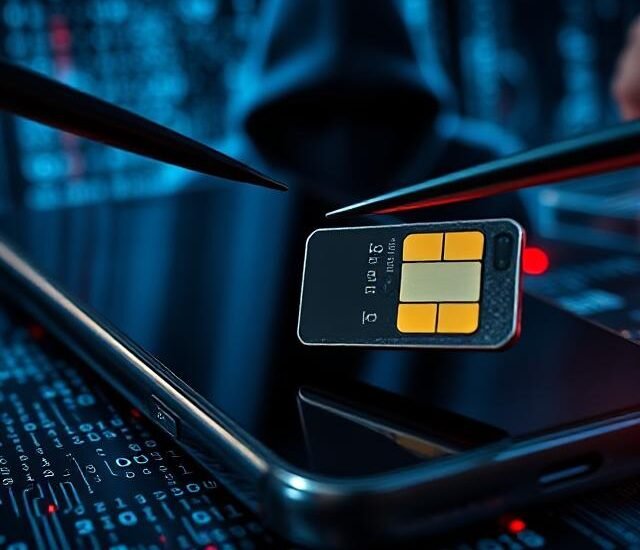In the early days of mobile security, a simple 4-digit PIN and a bit of common sense were enough to keep prying eyes away from your digital life. But in 2025, cyber threats have evolved far beyond brute force attacks or phishing emails. One of the most dangerous — and least understood — is SIM swapping, a subtle yet devastating attack that can compromise your entire identity in minutes.
With mobile devices becoming the primary gateway to banking, email, authentication apps, and digital wallets, securing your phone is no longer optional — it’s essential. This article explores the evolving landscape of mobile cyber security, why traditional methods like passwords are no longer enough, and how to shield your SIM and smartphone from today’s most pressing digital dangers.
What Is SIM Swapping and Why Is It So Dangerous?
The Anatomy of a SIM Swap Attack
SIM swapping — also known as SIM hijacking — is when a cybercriminal gains control of your phone number by tricking or bribing a carrier into switching it to a new SIM card under their control. Once they control your number, they can intercept:
- SMS-based 2FA codes
- Bank authentication messages
- Password reset links
This gives them access to email, financial accounts, crypto wallets, and more — even without knowing your passwords.
Real-World Consequences
Victims of SIM swap attacks have lost:
- Entire crypto portfolios
- Business logins
- Bank funds
- Control of social media and email accounts
This is not a theoretical threat — it’s a growing reality.
The Inadequacy of Traditional Mobile Security
PINs and Passwords Are Obsolete
A 6-digit phone unlock code won’t save you from an attacker who already has your phone number. Nor will a strong email password, if your two-factor authentication is routed through a compromised SIM.
The reality is, passwords and PINs were designed for an earlier age. Today’s threats require layered, adaptive, and hardware-backed protection.
Common Mistakes That Leave You Vulnerable
- Using SMS-based 2FA instead of authenticator apps or hardware tokens
- Storing sensitive data unencrypted on your mobile device
- Not securing your SIM card with a carrier-level PIN or port freeze
Building a Fortress: Best Practices for Mobile Cybersecurity
Secure Your SIM Card First
Start with these SIM protection tactics:
- Add a carrier PIN or passphrase to prevent unauthorized porting
- Request a SIM lock/freeze from your provider
- Enable alerts for SIM or number changes
These basic steps reduce the chance of unauthorized SIM transfers.
Learn more about this on Mobilen’s Prevent SIM Swap Guide.
Go Beyond SMS-Based 2FA
Instead of relying on text messages:
- Use authenticator apps like Google Authenticator or Authy
- Use hardware security keys (YubiKey, Titan Key) for the highest protection
- Switch to passkeys or biometric authentication where possible
Use the Best Mobile Security Tools
Invest in:
- The best mobile virus protection software
- End-to-end encrypted messaging apps
- A secure mobile network or VPN for public Wi-Fi protection
Remember, even the most secure mobile phone is only as safe as the practices of its user.
Mobile Device Security in a Post-Quantum Future
The Cryptographic Shift Ahead
Quantum computers are expected to break classical encryption — including RSA and ECC — within the next decade. That means today’s secure messaging, banking, and authentication protocols could be obsolete.
For this reason, post-quantum cryptography (PQC) is becoming critical. It ensures encryption can withstand quantum-level attacks.
Preparing Your Mobile Life for the Quantum Age
To future-proof your mobile life:
- Use apps and services that are transitioning to PQC protocols
- Watch for operating system updates that integrate quantum-safe cryptography
- Choose reputable mobile security providers that actively update encryption methods
The Role of AI in Mobile Threats — and Defenses
Smarter Threats Need Smarter Protection
AI isn’t just used in mobile assistants — hackers now use machine learning to craft phishing messages, mimic user behavior, and exploit weak authentication flows. The line between human and bot attackers is blurring.
That’s why mobile cyber defense is also going AI-native:
- Behavioral biometrics (like how you type or move your phone)
- Anomaly detection for malicious apps
- Adaptive firewalls that learn user habits
Is Your Phone Truly Secure? A 10-Point Checklist
Use this as your mobile security audit:
- SIM card is protected with a carrier PIN
- Phone lock uses biometrics or long alphanumeric code
- No SMS-based 2FA — only app or hardware token
- Best phone security software is installed and updated
- Regular OS and security patches are enabled
- Mobile antivirus is active
- VPN is used on public networks
- Backups are encrypted and off-device
- Access logs are regularly reviewed
- App permissions are routinely audited
If you’ve missed any, you’re not alone — but now is the time to lock down your mobile life.
Conclusion: Mobile Cybersecurity Isn’t Optional — It’s Survival
We live in an era where our entire digital identity lives on our phones — from money and health records to communication and authentication. And yet, most people still rely on outdated protections like simple passwords or SMS-based 2FA.
Mobile device security is no longer about convenience. It’s about survival.
To thrive in this new landscape, we must look beyond traditional protections — beyond PINs and passwords — and embrace a holistic approach to mobile cyber security. Whether that means SIM protection, biometric security, or post-quantum encryption, the time to act is now.






